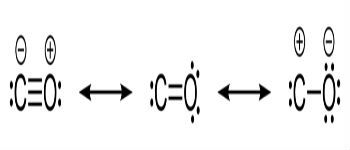Carbon monoxide is a colorless, odorless, flammable and toxic gas.
Its molecular formula is CO . It consists of a molecule of carbon and oxygen.

It originates in two ways:
- Natural emitting sources : activity of volcanoes, natural gas and electrical discharges.
- Human activities : result of incomplete combustion of fossil fuels. The fires produce tons of CO, being one of the main activities that release CO into the atmosphere.
Features
Carbon monoxide belongs to the group of oxides . It is classified as neutral oxide , those formed by an ametal plus oxygen. In addition, it does not react with water, acids and bases.
It is used as a reducing agent, removes oxygen from a compound and produces carbon dioxide (CO 2 ). Therefore, its use in the processing of ores, such as iron, is very common. As well, in the production of organic substances, such as acetic acid, plastics, methanol, among others.
When it reacts with oxygen in the air, it produces carbon dioxide. According to the following chemical reaction: 2 CO + O 2 → 2 CO 2
In surface waters, the high concentration of carbon monoxide serves as an energy source for microorganisms.
Carbon monoxide is one of the greenhouse gases . Its concentration in the atmosphere contributes to greater heat retention. It is therefore considered a polluting gas.
Intoxication
CO has a high affinity for hemoglobin. Because it is toxic, its inhalation has effects on human health and can even lead to death.
Because the CO has no smell, it may be being inhaled without being noticed. Therefore, in some cases, the person takes time to notice the intoxication.
When inhaled in low concentration, it causes migraines, sluggish thinking, eye irritation and loss of hand ability. In high concentrations it can cause seizures, loss of consciousness and even death from asphyxiation.
But how does intoxication happen?
The hemoglobin binds naturally to the second and carries the body tissues. However, the affinity between CO and hemoglobin is much higher, about 250 times more than with O 2 .
In the presence of CO, hemoglobin binds to it, preventing the transport of oxygen to cells. The combination of CO and hemoglobin gives rise to carboxyhemoglobin.
The main causes of CO poisoning occur in the following situations:
- Car engines running indoors;
- Burning of natural gas in inefficient heaters;
- Escape from kitchen gas or wood oven in poorly ventilated places.
In cold climate countries, houses tend to stay closed for longer and use heating systems. To avoid accidents with gas, CO detectors are increasingly used.
